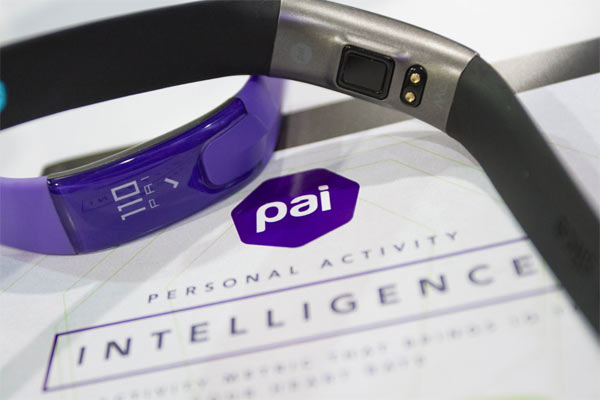Fitness trackers are designed to help users get fit by counting steps. However, this isn’t the case with the Mio Slice. This fitness tracker shifts its attention to heart rate. Mio has its own PAI metric that determines your activeness throughout the week and assists you to achieve your desired shape. It works the same way as a Fitbit where it tracks work sessions, daily activity, automatically log sleep and comes with some Smartwatch-style features as well.
Design And Comfort
The Mio Slice isn’t a fitness tracker for people looking for style and sleekness. It comes with a plastic matte black TPU band that is almost the same as the Charge 2 in width. Also, it comes with a non-touch screen OLED display and a physical button for skipping through data screens. The Slice is available in a variety of colors to choose from including Navy, Sienna, and stone.
The Mio Slice comes in two sizes; small and large. Although the screen allows for easy viewing especially when indoors, the same can’t be said about outside viewing.
Fitness Tracking
![]()
The Mio Slice packs a standard 3-axis accelerometer that tracks motion, provides data on distance covered, steps, and monitors sleep. Moreover, it provides current calorie score based on Mio’s heart rate sensor readings and algorithms.
When coming to sleep monitoring, the Slice’s data inaccuracies is a bit concerning. When put against other fitness monitors such as the Spark 3 and Fitbit Charge 2, the Slice appears to record short sleep times. Although it doesn’t come with dedicated sports monitoring modes, logging workout session is still possible. It comes with a big button just below the screen for the same.
Pai Scoring
The metric of Mio is based on gender, age, maximum heart rate and resting heart rate. The calculation of PAI score is based on the intensity of your heart rate within a week. The major objective is to maintain it above 100. It shows how hard you’ve worked your body without only relying on the steps you’ve taken. The algorithms used by Mio are based on the HUNT study, which is a long-standing health study. The study claims that resting heart rates can be used to predict cardiovascular health. Additionally, the HUNT study argues that by maintaining your PAI score 100 and above you can increase your lifespan by about ten years.

Heart Rate Tracking
As we’ve seen, the Mio Slice makes heart rate monitoring its focal point. Unsurprisingly, it does an excellent job when it comes to accurate data delivery. This has been the trend with previous Mio devices. When put against the Spark 3 and the H7 chest strap, the Slice shows consistent resting heart rate readings. Moreover, it handles out running and stationary bike workouts of high intensity with no issues. In general, Slice’s heart rate tracking is highly efficient.
Notifications
Although Mio doesn’t put a lot of emphasis on design, it embraces the idea of keeping users away from their smartphones. Users can comfortably view their notifications directly from the Slice’s display. The Slice doesn’t support activities such as music playback control but perfectly doubles as a watch. You can conveniently use gestures to wake the screen up by simply raising your arm.
Unlike an Android Wear Smartwatch or an Apple Watch, the Slice is more basic when it comes to caller ID, flashing up calendar icons, notifications, and contact name flashing. Note that little information is available on Slice and you’ll need to pick your phone to act on your notifications.
The App

Mio’s companion apps keep things pretty streamlined. In fact, things get even better with the Mio PAI 2 app. The app is available for Android and iOS. Presently, the app has ditched the old dark hue. It is now cleaner and brighter allowing easier data digestion. Weekly PAI scores are displayed on the home screen. There is also a second tab that reveals daily breakdown of moderate, high, and low heart rate scoring. Also, you can view sleep and activity data here. The last tab is meant for hardware customization and battery status viewing.
Battery Life
According to Mio, users can get a battery life of more than five days from the Slice. This battery life is sufficient for an entire day and night usage. The battery allows for fast charging. Mio claims that the battery can charge up to 100% within an hour from 0%. It comes with a Micro USB for charging. It perfectly clips on the Slice’s back for secure charging. Moreover, the Micro USB doesn’t budge when propped up a bedside table.
Another Amazing Wearable To Explore: Training Right And Making It Worth Your While With Moov Now
Conclusion
Currently, the Mio Slice is priced at $129. Its pricing is similar to that of the Fitbit Alta and a little lower than that of the Fitbit Charge 2. The decision to opt for heart rate doesn’t come as a surprise, especially considering Mio’s previous devices such as the Alpha and Fuse, which relied on BPM readings. Although Mio trackers have great heart rate tracking skills, they still need to improve more.


